|
|||||||||||||||||||
|
|
|||||||||||||||||||
The Hubble Space Telescope Frontier Fields Data Access Pages
The Frontier Fields Lens Models
Introduction |
Lens Models and Input Data |
Magnification Calculator |
Acknowledgements |
| Latest Updates | |||
| 26 Nov. 2018 - Bradac v4.1 for Abell 370 now available. | |||
| 24 Aug. 2018 - Sharon v4 models corrected for Abell 2744, MACS 0416, MACS 0717, and MACS 1149 ("v4cor" = fixed; "v4orig" = old v4 files incorrectly scaled except *magnif* files which were correct). Diego v4 and v4.1 deflection maps corrected (in-place, no new files added, change is a reduction by a factor of 60). Abell 370 Bradac v4 and MACS 0717 Williams v4.1 models added. Williams v4 and v4.1 deflection maps added for all clusters. | |||
| 06 Dec. 2017 - v4 GLAFIC added for Abell 2744, MACS 0416, Abell S1063, and Abell 370. | |||
| 03 Nov. 2017 - v4 Sharon, v4 Keeton, v4+v4.1 Williams, v4+v4.1 Diego, v4+v4.1 CATS added for Abell S1063 and Abell 370. | |||
| 10 May 2017 - v4 Sharon, v4 Williams, v4 + v4.1 CATS, v4+v4.1 DIEGO added for Abell 2744, MACS 0416, MACS 0717, and MACS 1149. v4 Keeton (new group) added for same clusters. v4 Caminha (new group) added for MACS 0416. | |||
| 06 Sep. 2016 - Bradač v3 models for MACS 0416, from Hoag et al. 2016, now available. | |||
| 17 Feb. 2016 - The GLAFIC version 3 deflection maps and README files have been updated. Also, the Diego version 3 MACS0416 x-pixels-deflect FITS file has been replaced with the correct file. |
| Abell 2744: Overlay of magnification (red) and mass models (blue) on the full-band HST imaging (green) | ||||
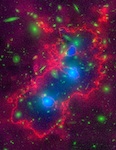
| 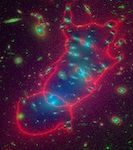
| 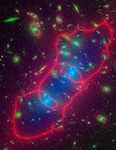
| 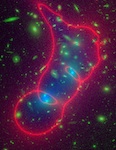
| 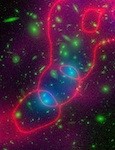
|
| Bradač et al. | CATS Team | Merten, Zitrin et al. | Sharon et al. | Williams et al. |
Introduction
The Frontier Fields (FF) are selected to be among the strongest lensing clusters on the sky. In order to interpret many of the properties of background lensed galaxies, reliable models of the lensing maps for each cluster are required. Preliminary models for each of the six Frontier Fields clusters have been provided by five independent groups prior to the HST Frontier Fields observing campaign in order to facilitate rapid analysis of the FF data by all members of the community. These models are based upon a common set of input data, including pre-FF archival HST imaging and a common set of lensed galaxies.
The public Frontier Fields lens models include maps of mass (kappa) and shear (gamma) from which magnifications can be derived at any redshift using the script provided. Magnification maps pre-computed at z = {1,2,4,9} are also available for download. The models cover regions constrained by strongly lensed, multiply-imaged galaxies, within the HST ACS fields of view of the cluster cores. The Merten models extend to larger areas, including the FF parallel fields, as they incorporate ground-based weak lensing data. For a description of the methodology adopted by each group, see
this webpage, and the links to each map-maker
below.
Also see this primer on gravitational lensing.
Lens Models and Input Data
|
|
|
Interactive Web Tool - Magnification Calculator
We have developed an interactive web tool which calculates the magnification and uncertainties for each model, given an input RA, DEC, redshift and (optionally) an lensed image radius. The magnifications at a given redshift are calculated directly from the kappa (mass) and gamma (shear) maps; they are not interpolations of the z={1,2,4,9} magnification maps. The uncertainties are derived from the ranges of values in ~100 realizations of each model submitted by the map makers.
Acknowledgements
The Frontier Fields lensing map-making teams are:
The lens models were derived based on strongly lensed galaxies identified in archival HST imaging in previous works and as part of this project. Other lens model ingredients were spectroscopic redshifts of lensed and cluster galaxies; and ground-based imaging (primarily for weak lensing analyses). The lens modelers shared all of these data prior to performing their analyses.
Subsequent lens models (based in part on the Frontier Fields HST imaging) have been provided by some of the teams listed above, as well as:
Please acknowledge the following references in any science publications and presentations:
- - Lotz et al. 2017, ApJ, 837, 97 ADS (Frontier Fields HST data and survey design)
Please acknowledge the use of these public Frontier Fields lensing maps in any science publications and presentations with the following:
"This work utilizes gravitational lensing models produced by PIs Bradač, Natarajan & Kneib (CATS), Merten & Zitrin, Sharon, Williams, Keeton, Bernstein and Diego, and the GLAFIC group. This lens modeling was partially funded by the HST Frontier Fields program conducted by STScI. STScI is operated by the Association of Universities for Research in Astronomy, Inc. under NASA contract NAS 5-26555. The lens models were obtained from the Mikulski Archive for Space Telescopes (MAST)."
|
|
|




 Follow Us
Follow Us